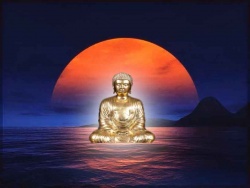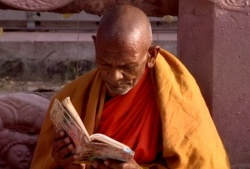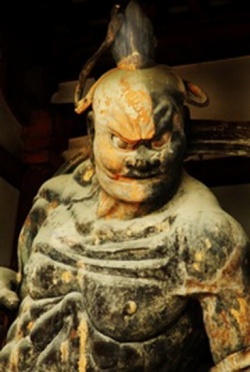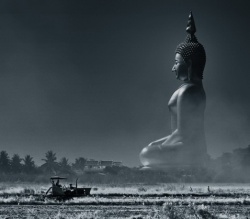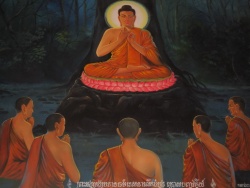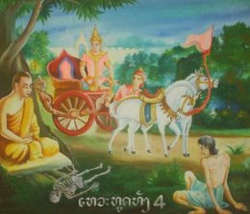Dukkha
suffering
苦 (Skt duhukha; Pali dukkha; Jpn ku )
Buddhism describes various categories of suffering, such as the four sufferings and the eight sufferings. The Sanskrit term duhukha (duhkha according to standard alphabetization) is rendered as suffering. It also means uneasiness, pain, sorrow, trouble, or difficulty. Shakyamuni's renunciation of the world and quest for enlightenment was motivated by a desire to find a solution to the four sufferings of birth, aging, sickness, and death.
The first of the four noble truths, which Shakyamuni is said to have taught in his first sermon after attaining enlightenment, is the truth of suffering, i.e., the truth that all existence is suffering. Thus, the seeking and attaining of the way of release from suffering became the object of Buddhist practice. The doctrine that all existence is suffering constitutes one of the four
Dharma seals, the four basic identifying principles of Buddhism; the other three are that all existence is impermanent, that nothing has an independent existence of its own, and that nirvana, enlightenment, is tranquil and quiet. See also four sufferings; eight sufferings.
Dukkha (Pāli; Sanskrit: duḥkha ; Tibetan phonetic: dukngal) is a Buddhist term commonly translated as "Suffering", "stress", "anxiety", or "dissatisfaction". Dukkha is identified as the first of The Four Noble Truths.
Within the Buddhist tradition, dukkha is commonly explained according to three different patterns or categories. In the first category, dukkha includes the obvious physical Suffering or pain associated with giving birth, growing old, physical illness and the process of dying. These outer discomforts are referred to as the dukkha of ordinary Suffering (dukkha-dukkha). In a second category, dukkha
also includes the anxiety or stress of trying to hold onto things that are constantly changing; these inner anxieties are called the dukkha produced by change (vipariṇāma-dukkha). The third pattern or category of dukkha refers to a basic unsatisfactoriness pervading
all forms of Life because all forms of Life are Impermanent and constantly changing. On this level, the term indicates a lack of satisfaction, a sense that things never measure up to our expectations or standards. This subtle dissatisfaction is referred to as the dukkha of conditioned states (saṃkhāra-dukkha).
Neither pessimistic nor optimistic, but realistic
The central importance of dukkha in Buddhist Philosophy is not intended to present a pessimistic view of Life, but rather to present a realistic practical assessment of the human condition—that all beings must experience Suffering and
pain at some point in their lives, including the inevitable sufferings of illness, aging, and Death. Contemporary Buddhist teachers and translators emphasize that while the central message of Buddhism is optimistic, the Buddhist
view of our situation in Life (the conditions that we live in) is neither pessimistic nor optimistic, but realistic.
Walpola Rahula explains the importance of this realistic point of view:
- First of all, Buddhism is neither pessimistic nor optimistic. If anything at all, it is realistic, for it takes a realistic view of Life and of the World. It looks at things objectively (yathābhūtam). It does not falsely lull you into living in a fool's paradise, nor does it frighten and agonize you with all kinds of imaginary fears and sins. It tells you exactly and
objectively what you are and what the World around you is, and shows you the way to perfect freedom, peace, tranquility and Happiness. One physician may gravely exaggerate an illness and give up hope altogether. Another may ignorantly declare that there is no illness and that no treatment is necessary, thus deceiving the patient with a false consolation.
You may call the first one pessimistic and the second optimistic. Both are equally dangerous. But a third physician diagnoses the symptoms correctly, understands the cause and the nature of the illness, sees clearly that it can be cured, and courageously administers a course of treatment, thus saving his patient. The Buddha is like the last physician. He is the wise and scientific doctor for the ills of the World (Bhisakka or Bhaisajya-Guru).
Surya Das emphasizes the matter-of-fact nature of dukkha:
- Buddha Dharma does not teach that everything is Suffering. What Buddhism does say is that Life, by its nature, is difficult, flawed, and imperfect. [...] That's the nature of Life, and that's the first noble truth. From the Buddhist point of view, this is not a Judgement of Life's joys and sorrows; this is a simple, down-to-Earth, matter-of-fact description.
The Buddha acknowledged that there is both Happiness and sorrow in the World, but he taught that even when we have some kind of Happiness, it is not permanent; it is subject to change. And due to this unstable, Impermanent nature of all things, everything we experience is said to have the quality of duhkkha or unsatisfactoriness. Therefore unless we can gain Insight into that Truth,
and understand what is really able to provide lasting Happiness, and what is unable to provide Happiness, the experience of dissatisfaction will persist. Three patterns
Within the Buddhist tradition, dukkha is commonly explained according to three different patterns or levels or categories:
- Pali: dukkha-dukkha
- Also referred to as the Suffering of Suffering.
- Includes the sufferings of birth, aging, sickness, Death, and coming across what is not desirable.
- This outer level of dukkha includes all of the obvious physical Suffering or pain associated with giving birth, growing old, physical illness and the process of dying.
- Dukkha produced by change
- Pali: viparinama-dukkha
- Also referred to as: Suffering of change or Suffering of Impermanence.
- Includes two categories: trying to hold onto what is desirable, and not getting what you want.
- Buddhist author Chogyam Trungpa includes the category "not knowing what you want."
- Pema Chödrön described this type of Suffering as the Suffering of trying to hold onto things that are always changing.
- This inner level of dukkha includes the anxiety or stress of trying to hold onto things that are constantly changing.
- Dukkha of conditioned states
- Pali Sankhara-dukkha
- Also referred to as all-pervasive Suffering
- This category is also identified as one of the "eight types of Suffering".
- Pema Chodron describes this as the Suffering of ego-clinging; the Suffering of struggling with Life as it is, as it presents itself to you; struggling against outer situations and yourself, your own emotions and thoughts, rather than just opening and allowing.
- This is a subtle Form of Suffering arising as a reaction to qualities of conditioned things, including the Skandhas, the factors constituting the human Mind.
- This is the deepest, most subtle level of dukkha; it includes "a basic unsatisfactoriness pervading all existence, all forms of Life, due to the fact that all forms of Life are changing, Impermanent and without any inner core or substance."
- On this level, the term indicates a lack of satisfaction, a sense that things never measure up to our expectations or standards.
Types
Eight types
Dukkha can also be categorized into eight types belonging to the three categories of: inherited Suffering, the Suffering between the period of birth and Death, and general misery. Chogyam Trunga explains these categories as follows:
Inherited Suffering:
- Birth: the discomfort of birth and experiencing the World for the first time; and the discomfort of relating to new demands or experiences.
- Old age: the discomfort involved in the process of aging and growing old; this can apply to psychological as well as physical discomfort of aging.
- Sickness: the discomfort of physical or psychological illness.
- Death: includes the pain of separation and not being able to continue on in your endeavors, as well as the physical discomfort of dying.
Suffering between the periods of birth and Death:
- Getting what you don't want: being unable to avoid difficult or painful situations.
- Not being able to hold onto what is desirable: the pain of trying to hold onto what is desirable, lovely, splendid, terrific.
- Not getting what you do want: this underlies the previous two categories; the anxiety of not getting what you want.
General misery:
- All-pervasive Suffering: a very subtle dissatisfaction that exists all the time; it arises as a reaction to the qualities of conditioned things (e.g. the Impermanence of things).
Six types
Aung San Suu Kyi presented a list of six great dukkha at her Nobel Lecture, delivered on 16 June, 2012. These are:
- To be conceived
- To age
- To sicken
- To die
- To be parted from those one loves
- To be forced to live in propinquity with those one does not Love
Three marks of existence
- See also: Three marks of existence
Dukkha is also listed among the three marks of existence. These are:
In this context, dukkha denotes the experience that all formations (Sankhara) are Impermanent (Anicca) - thus it explains the qualities which make the Mind as fluctuating and Impermanent entities. It is therefore also a gateway to Anatta, not-self.
Developing Insight into dukkha
Canonical Buddhist teachings emphasize the importance of practicing Meditation to develop Insight into dukkha. The subtle nature of dukkha eludes an unprepared Mind, as noted in Samyutta Nikaya #35, in which The Buddha says:
- What ordinary folk call Happiness, the Enlightened ones call dukkha.
The Anapanasati Sutta and Mahāsatipaṭṭhāna Sutta each affirm that a person first needs to practice Meditation (jnana) to purify the Mind of the five hindrances to Insight before contemplating The Four Noble Truths, which begin with the nature of "dukkha" in Life.
Without experience of Meditation, one's Knowledge of the World is too limited to fully understand dukkha, as required by the first noble truth, and proceed to Enlightenment.
Contemporary scholar Micheal Carrithers also emphasizes the need to examine one's Life. Carrithers asserts that insofar as it is dynamic, ever-changing, uncontrollable and not finally satisfactory, unexamined Life is itself precisely dukkha. Carrithers also asserts that the
question which underlay The Buddha's quest was "in what may I place lasting relevance?" He did not deny that there are satisfactions in experience: the exercise of Vipassana assumes that the meditator sees instances of Happiness clearly. Pain is to be seen as pain, and pleasure as pleasure. It is denied that Happiness dependent on conditions will be secure and lasting.
Contemporary Buddhist teacher Ajahn Brahm emphasizes this point using a simile that compares the experience of dukkha to being in prison, and compares Meditation (Pali: Jhana) to a tunnel that leads out of the prison:
- Another simile [...] is that of the man who was born and raised in a prison and who has never set foot outside. All he knows is prison Life. He would have no conception of the freedom that is beyond his World. And he would not understand that prison is Suffering. If anybody suggested that his World was dukkha, he would disagree, for prison is the limit of his
experience. But one day he might find the escape tunnel dug long ago that leads beyond the prison walls to the unimaginable and expansive World of real freedom. Only when he has entered that tunnel and escaped from his prison does he realize how much Suffering prison actually was, and the end of that Suffering, escaping from jail is Happiness.
- In this simile the prison is the Body, the high prison walls are the five senses, and the relentless demanding prison guard is one's own will, the doer. The tunnel dug long ago, through which one escapes, is called Jhana meditation (as at AN IX, 42). Only when one has experienced Jhana does one realize that the five-sense World, even at its best, is really a five-walled prison,
some parts of it is a little more comfortable but still a jail with everyone on Death row! Only after deep Jhana does one realize that "will" was the torturer, masquerading as freedom, but preventing one ever resting happily at peace. Only outside of prison can one gain the data that produces the deep Insight that discovers the Truth about dukkha.
- In summary, without experience of Jhana, one's Knowledge of the World is too limited to fully understand dukkha, as required by the first noble truth, and proceed to Enlightenment.
Contemporary Buddhist teacher Chogyam Trungpa explains that Meditation is designed to develop an understanding of dukkha:
- Understanding Suffering dukkha is very important. The practice of Meditation is designed not to develop pleasure, but to understand the Truth of Suffering; and in order to understand the Truth of Suffering, one also has to understand the Truth of awareness. When true awareness takes place, Suffering does not exist. Through awareness, Suffering is somewhat changed in its
perspective. It is not necessarily that you do not suffer, but the haunting quality that fundamentally you are in trouble is removed. It is like removing a splinter. It might hurt, and you might still feel pain, but the basic cause of that pain, the ego, has been removed.
Relation to the Five Skandhas
According to the Buddhist tradition, the dukkha of conditioned states (saṃkhāra-dukkha) is related to clinging to the Skandhas. Oxford scholar Noa Ronkin discusses the relation between the Skandhas (Sanskrit; Pali: Khandhas) and dukkha:
- Her conclusion is that the associating of the Five Skandhas as a whole with dukkha indicates that experience is a combination of a straightforward cognitive process together with the psychological orientation that colors it in terms of unsatisfactoriness.
Experience is thus both cognitive and affective, and cannot be separated from Perception. As one's Perception changes, so one's experience is different: we each have our own particular cognitions, perceptions and volitional activities in our own particular way and degree, and our own way of responding to and interpreting our experience is our very experience.
In Harmony with this line of Thought, Gethin observes that the Skandhas are presented as five aspects of the nature of conditioned existence from the point of view of the experiencing subject; five aspects of one's experience. Hence each Khandha represents 'a
complex class of Phenomena that is continuously arising and falling away in response to processes of Consciousness based on the six spheres of sense. They thus become the five upādānakhandhas, encompassing both grasping and all that is grasped.'
Within Buddhist literature
Dukkha appears frequently in Buddhist texts. Jeffrey Po explains:
- Dukkha is an extremely important concept and is central to understanding Buddhism in its entirety. It appears in the first of The Four Noble Truths and as one of The Three Characteristics of Existence. References to "dukkha" as one of Life's situations abound in many of the suttas delivered by Lord Buddha Himself as well as in numerous Buddhist philosophical and psychological thoughts.
The Four Noble Truths deal with the nature of "dukkha" in Life, what is the cause of "dukkha", the cessation (cure) for "dukkha", and the techniques to bring about the cessation of "dukkha".
the first noble truth is presented within The Buddha's first discourse, Setting in Motion the Wheel of the Dharma (Dharmacakra Pravartana Sūtra), as follows:
- "This is the Noble Truth of dukkha: birth is dukkha, aging is dukkha, illness is dukkha, Death is dukkha; sorrow, lamentation, pain, Grief and despair are dukkha; union with what is displeasing is dukkha; separation from what is pleasing is dukkha; not to get what one wants is dukkha; in brief, The five aggregates subject to clinging are dukkha."
Texts like the Cula-Malunkyovada Sutta and Anuradha Sutta, show Buddha as insisting that the truths about dukkha and the way to end dukkha are the only ones he is teaching as far as attaining the ultimate goal of Nirvana is concerned.
Within non-Buddhist literature
Hinduism
In Hindu literature, the earliest Upaniṣads — the Bṛhadāraṇyaka and the Chāndogya — are believed to predate or coincide with the advent of Buddhism. In these texts' verses, the Sanskrit word duḥkha (translated below as "Suffering" and "distress") occurs only twice. In the Bṛhadāraṇyaka Upaniṣad, it states (in English and Sanskrit):
| English | Sanskrit |
|---|---|
| While we are still here, we have come to know it [(Ātman). If you've not known it, great is your destruction. Those who have known it — they become immortal. As for the rest — only Suffering awaits them. |
ihaiva santo 'tha vidmas tad vayaṃ na ced avedir mahatī vinaṣṭiḥ ye tad vidur amṛtās te bhavanty athetare duḥKham evāpiyanti |
In the Chāndogya Upaniṣad, it is written:
| English | Sanskrit |
|---|---|
|
When a man rightly sees, |
na paśyo mṛtyuṃ paśyati na rogaṃ nota duḥkhatām |
Thus, as in Buddhism, these texts emphasize that one overcomes duḥkha through the development of a transcendent understanding.
Panetics
In 1986, the Journal of Humanistic Psychology published an article by Ralph G.H. Siu entitled Panetics—The Study of the Infliction of Suffering. In the abstract for the article, Sui proposed using the term dukkha as a quantitative measurement; he wrote:
- After analyzing the unceasing mutual inflictions of Suffering by practically everyone and the neglect of this pervasive and degenerating human deficiency by the academic community, I urge the immediate creation of a new and vigorous academic discipline, called panetics, to be devoted to the study of the infliction of Suffering. The nature, scope, illustrative contents, and social value are outlined. The dukkha is proposed as a semiquantitative unit of Suffering to assist in associated analytical operations.
Related publications include:
- Panetics: The study of the infliction of Suffering. J. Humanistic Psychology 28(3), 6-22. 1988
- The humane chief of state and the Gross National Dukkhas (GND). Panetics 2(2), 1-5. 1993.
- Panetics Trilogy. The International Society for Panetics, 1994.
- Vol. I, Less Suffering for Everybody. Ibid.
- Vol. II, Panetics and Dukkhas. Ibid.
- Vol. III, Seeds of Reflection, Panetic Word Clusters. Ibid
Etymology
The early Western translators of Buddhist texts (prior to the 1970s) translated the Pali term dukkha as "Suffering" and conveyed the impression that Buddhism was a pessimistic or World-denying philosophy. Later translators, however, including Walpola Rahula (What Buddha Taught, 1974) and nearly all contemporary translators, have emphasized that "Suffering" is too limited a translation for the term dukkha, and have preferred to either leave the term untranslated or to clarify that translation with terms such as unease, anxiety, stress, dissatisfaction, disquietude, etc.
Rupert Gethin explains:
- Rich in meaning and nuance, the word duḥkha is one of the basic terms of Buddhist and other Indian religious discourse. Literally 'pain' or 'anguish', in its religious and philosophical contexts duḥkha is, however, suggestive of an underlying sense of 'unsatisfactoriness' or 'unease' that must ultimately mar even our experience of Happiness.
On the deepest level, dukkha suggests a basic unsatisfactoriness pervading all forms of Life because all forms of Life are Impermanent and constantly changing. Dukkha indicates a lack of satisfaction, a sense that things never measure up to our expectations or standards.
Sargeant (2009: p. 303) explains the historical roots of duḥkha and its antonym Sukha:
- It is perhaps amusing to note the etymology of the words Sukha (pleasure, comfort, bliss) and duḥkha (misery, unhappiness, pain). The ancient Aryans who brought the Sanskrit Language to India were a nomadic, Horse- and cattle-breeding people who travelled in Horse- or ox-drawn vehicles. Su and dus are prefixes indicating good or bad. The word kha, in later Sanskrit meaning "sky," "ether," or "space," was originally the word for "hole," particularly an axle hole of one of the Aryan's vehicles. Thus Sukha … meant, originally, "having a good axle hole," while duhkha meant "having a poor axle hole," leading to discomfort.
According to grammatical tradition, dukkha is derived from dus-kha "uneasy", but according to Monier-Williams more likely a Prakritized Form of dus-stha "unsteady, disquieted". The Sanskrit prefix 'su' is used as an emphasis suggesting wholesome, high, evolved, desirable, strong and such.[web 18]
Dukkha was translated as kǔ (苦 "bitterness; hardship; Suffering; pain") in Chinese Buddhism, and this loanword is pronounced ku (苦) in Japanese Buddhism and ko (苦) in Korean Buddhism, and khổ in Vietnamese Buddhism. The Tibetan (phonetic) is dukngal. In Shan, it is [tuk˥kʰaː˥] and in Burmese, it is [doʊʔkʰa̰].
Alternate translations
Translations used for dukkha in the context of The Four Noble Truths are:
- A basic unsatisfactoriness pervading all existence (Bhikkhu Bodhi)
- Anguish
- Anxiety (Chogyam Trungpa, The Truth of Suffering, pp. 8–10)
- Affliction (Brazier)
- Dissatisfaction (Pema Chodron, Chogyam Trunpa)
- Discomfort
- Discontent
- Frustration (Dalai Lama, Four Noble Truths, p. 38)
- Misery
- Sorrow
- Stress (Thanissaro Bhikkhu, Jon Kabat-Zin)
- Suffering (Thich Nhat Hanh, Ajahn Succito, Chogyam Trungpa, Rupert Gethin, Dalai Lama, et al.)
- Uneasiness (Chogyam Trungpa)
- Unease (Rupert Gethin)
- Unhappiness
- Unsatisfactoriness (Rupert Gethin; Dalai Lama, Four Noble Truths, p. 38; Piyadassi Thera, The Ancient Path)



